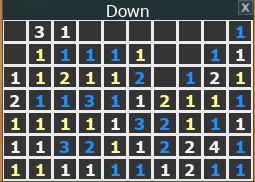Difference between revisions of "User/Telanoc/RuneGuide"
From A Wiki in the Desert
| Line 15: | Line 15: | ||
# The number of a given color square within a row or columns | # The number of a given color square within a row or columns | ||
# The pattern of those squares, as follows: | # The pattern of those squares, as follows: | ||
| − | ## A color/number tells you number of adjacent squares of that color. For example a blue 3 tells you there are three squares colored blue next to each other in the row or column | + | ## A color/number tells you number of adjacent squares of that color. For example a blue 3 tells you there are three squares colored blue next to each other in the row or column. From the example above we can see that Row 1 (The top most) has Three White Squares, then One Yellow Square, and then Three Blue Squares. |
| − | ## If there are two numbers of the same color next to each other, then there will be those numbers with at least one blank space between them | + | ## If there are two numbers of the same color next to each other, then there will be those numbers with at least one blank space between them. From the examples above we can see that column 10 (the right most) has One Blue Square, and then one or more blanks, then another single One Blue Square. |
## If the sum of all the numbers is 10, you can complete the row or column solely on the information provided. | ## If the sum of all the numbers is 10, you can complete the row or column solely on the information provided. | ||
## If the sum of all the numbers is LESS than 10, the remaining spaces are blank. | ## If the sum of all the numbers is LESS than 10, the remaining spaces are blank. | ||
Revision as of 04:42, 11 November 2021
The Alchemist Rune is one of the more challenging of the puzzles to solve in Egypt. This is the method I use to solve Alchemist's Rune.
Start Up and Concepts
When you start to play the puzzle you will be presented with a blank table like this:
You will also be presented with two tables that tell you the pattern you need to make. They look like this:
- The Across or Rows Table:
- The Down or Columns Table:
Both tables tell you the following information:
- The number of a given color square within a row or columns
- The pattern of those squares, as follows:
- A color/number tells you number of adjacent squares of that color. For example a blue 3 tells you there are three squares colored blue next to each other in the row or column. From the example above we can see that Row 1 (The top most) has Three White Squares, then One Yellow Square, and then Three Blue Squares.
- If there are two numbers of the same color next to each other, then there will be those numbers with at least one blank space between them. From the examples above we can see that column 10 (the right most) has One Blue Square, and then one or more blanks, then another single One Blue Square.
- If the sum of all the numbers is 10, you can complete the row or column solely on the information provided.
- If the sum of all the numbers is LESS than 10, the remaining spaces are blank.


